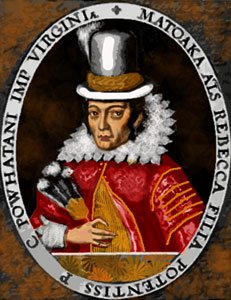
The picture at left is based on an engraving which had been made from a sketch taken from life in 1616 of the 19 year old Indian princess by Simon Van de Passe, published by Captain John Smith in 1624.
As I got up to leave the theatre showing The New World, an old man turned to his wife and said, "So whose story was that supposed to be?" "Pocahontas," explained the woman. "Really? Is that what really happened to her?" "I guess, but you know Hollywood."
In many ways the new film is as much fantasy as Disney's cartoon version. "Let's make a love story of these two people... Forget the facts--love stories sell," I can imagine some pitchman saying to the money men.
So change the facts they did. The first and most important one is that according to Camilla Townsend in Pocahontas and the Powhatan Dilemma (2004) , Pocahontas was only 10 years old (!!) when she was supposed to have saved the life of Captain John Smith. And that famous life saving moment may not have actually happened since it only appeared in Smith's reinvention and much later retelling of his own history in the Virginia colony of Jamestown--eight years after Pochantos' death.
The real story of Pocahontas is fairly simple. At around 10 she meets Captain Smith. They spent some time together and she helps him learn her language and she his. Later when he writes about her with erotic undertones, he changes her age to 15. Her name means "Mischief" and is a child's name--not what she considers her real name (Matoaka). She loves to do cartwheels and challenges the English boys to compete with her. She also becomes for two years a favorite of the Jamestown settlers.
Around the age of 15 Pocahontas marries for the first time an Indian warrior named Kokoom, who disappears from her life within a couple of years. She is taken prisoner by the English who plan to use her as a hostage against her father. She is converted to Christianity, baptized Rebecca, and marries an English widower named John Rolfe. [Rolfe had married an Englishwoman and together they were shipwrecked near Bermuda as they came to Virginia. Shakespeare uses that shipwreck as the basis for his The Tempest.] Together they become farmers of tobacco and have one son named Thomas. When Thomas is only around 1, the Rolfes go on a business trip to London, bringing along several of Pocahontas' people. There she is a social success, but she succumbs to the British germs and eventually dies as they start their journey home. John has to leave Thomas in England and never sees him again. John marries another Englishwoman and has a daughter. After his death, Thomas comes to America and inherits a great deal of property.
There is a meeting of Pocahontas and John Smith during the visit to London, but during it she berates him for having abandoned promises he had made to her father. Certainly it was not a bittersweet love farewell.
The filmmakers achieved very interesting historical mise-en-scene, but the story becomes a rather Roussean concept of "let's run in the forest with the naturals and find Paradise... but I'm not worth Paradise... etc." Colin Farrell has generally been an interesting actor (although he was absolutely awful in Stone's Alexander), but he progresses into his nature scenes, as he gives up the armor for beefcake tattoos, he attains the charisma needed for this sexual adventurer. (Block out of your mind that the girl he's seducing is only 10 in real life.)
The real knockout of the film, however, is Q'Orianka Kilcher as Pochantos. She is eloquent in her silences and speaks volumes with her eyes and gestures. Every scene with her takes life and succeeds. As a story of love lost, moving on, and letting the past go, she reminds me of Ennis in "Brokeback." She, for me, is worth the price of admission. The film itself is overlong and at times grates, but Kilcher redeems it.
So if a film successfully reproduces the look of the period but is essentially based on lies, how can one accept the veracity of any of it?

No comments:
Post a Comment